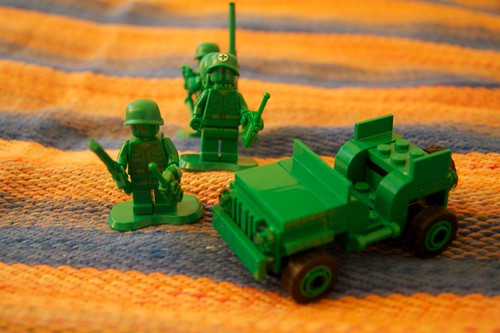Possibly my most favourite toy of all Toy Town, has always been Lego, and possibly my most favourite Lego kit, one which I bought just recently, is the Lego Toy Story Army Men.

Lego Toy Story Army Men
This may be the most postmodern toy ever made; A toy version of a cartoon version of an original toy. When you think about it, (or at least when I think about it), it simply boggles the mind. Life, imitating art, imitating one of the cheapest and most common toys around (at least, army men were incredibly common when I was a nipper. Maybe they’re not now. I know it’s frowned upon to give children toy guns these days. Is it frowned upon to give them plastic men holding plastic guns?). The postmodern interest in difference, separation, textuality, skepticism (thank you wikipedia) seems to be totally summed up in these small green plastic men. They are a representation of a representation of a representation of real soldiers. That’s four levels of abstraction from reality; further from reality than Peter Andre(POP CULTURE REFERENCE!).
What’s more, the Lego iteration of the army men are, in fact, a far more versatile toy than the original version that they represent. The classic plastic army men come in a variety of different poses, some waving plastic metal detectors, some lying on the ground, some kneeling by their little plastic mortars, but they are resolutely not posable Posability is a very big thing for collectables it seems. Toys aimed at adults often appear to make a huge deal about how many points of articulation they have. The classic army men have no points of articulation. Their Lego counterparts on the other hand, have many points of articulation, as well as interchangeable accessories, removable bases, and the ability to be disassembled, and combined with other Lego elements.


A Lego army man with a skull instead of a headThus the representation of the original toy is a more versatile, and thus arguably better, toy! This, on one level, strikes me as counter-intuitive. Seeing a photograph of the Grand Canyon is unlikely to be described by many as being better than being at the Grand Canyon. Toy Story Lego Army Men turn our notions of the genuine and the imitation on their head, with the copy being more genuine than the original.
The idea of toys based on the Toy Story movies raises interesting post modern questions in itself. The first Toy Story movie deals with Buzz Lightyear’s identity crisis and sudden loss of ontological security, as he is forced to come to terms with the fact that he is not an intergalactic space ranger, working for Star Command, but is, in fact, an action figure representation of a space ranger.* Buzz is shaken to the very core of his being, as everything he thinks he knows about himself is undermined, and the film chronicles his coming to terms with who and what he is. But if the Toy Story conception of toys being alive were true (and who is to say it isn’t?) what would the toys based on the movie think themselves to be? Would a Lego Buzz Lightyear think himself to be an actual Space Ranger? Or would he believe himself to be the Buzz Lightyear of the movie, wondering where were his compatriots from Andy’s bedroom were, and why he seemed to be made of interconnected but removable pieces? What would it do to one’s sanity to be forced to realise that one were not a Space Ranger charged with stopping the Emperor Zurg, nor even an action figure based on the cartoon adventures of such a character, but was in fact a toy of a cartoon of a toy version of such a cartoon? I think it would shatter his sanity completely, possibly leading him to embark on a vengeful killing spree. So, if I ever own a Lego Buzz Lightyear, I’ll be keeping him locked somewhere very safe when I’m sleeping...

Lego army men fighting a pirate riding on a giant robot crab
*An interesting point, for me anyway, is how the different toys all seem to have different conceptions of what they are. Buzz believes himself to be the fictional cartoon character that he is based on. Woody on the other hand, knows himself to be a toy, and seems in fact to be completely unaware of the TV show he is based on. The other toys all seem to lie somewhere between these two poles; for example the army men seem fully aware of their toy status, yet act in a stereotypically militaristic manner.
No comments:
Post a Comment